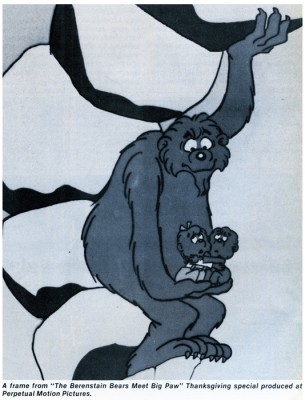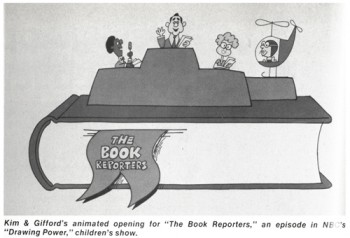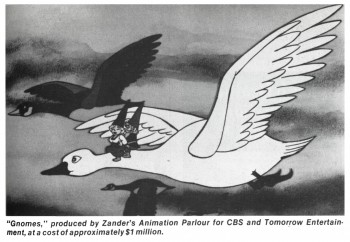Articles on Animation 16 Jan 2009 09:42 am
NY Makes it Big
 - For as long as I can remember, we, in NY, have been told that the big studio is returning. Again and again we hear that lots of big projects are coming, and we’ll all have to gear up for the glory days. I saw this with Raggedy Ann & Andy; I heard this with Shamus Culhane studio’s Noah’s Ark series of 1/2 hours (before he skipped town to do them in Italy.) It was obviously happening with the advent of Doug, and then MTV, or Courage the Cowardly Dog, or whatever.
- For as long as I can remember, we, in NY, have been told that the big studio is returning. Again and again we hear that lots of big projects are coming, and we’ll all have to gear up for the glory days. I saw this with Raggedy Ann & Andy; I heard this with Shamus Culhane studio’s Noah’s Ark series of 1/2 hours (before he skipped town to do them in Italy.) It was obviously happening with the advent of Doug, and then MTV, or Courage the Cowardly Dog, or whatever.
It always seems to get back to a few smallish studios (like mine) doing individual work. That’s jsut the way it is.
Here’s an article John Canemaker wrote for Millimeter magazine back in January 1981 (a year after I’d formed my studio.)
Return of “Long” Cartoons
by John Canemaker
 Recently, New York’s animation industry has been enjoying the flattering attention of the television networks in the area of TV specials and series. Last year, three animated prime-time specials and one Saturday morning series (live-action with animated segments) were produced in the Big Apple. With three specials currently on the drawing boards at one studio, and proposals for “longer” shows being prepared by several other local houses, it appears the East Coast, particularly New York City, is witnessing a new and healthy growth in television cartoon production.
Recently, New York’s animation industry has been enjoying the flattering attention of the television networks in the area of TV specials and series. Last year, three animated prime-time specials and one Saturday morning series (live-action with animated segments) were produced in the Big Apple. With three specials currently on the drawing boards at one studio, and proposals for “longer” shows being prepared by several other local houses, it appears the East Coast, particularly New York City, is witnessing a new and healthy growth in television cartoon production.
Busiest and one of the largest of the New York studios is 12-year-old Perpetual Motion Pictures, whose 1979 half-hour NBC special, “The Berenstain Bears’ Christmas Tree,” was the fifth highest rated out of 70 specials that year. The show’s success led to 1980′s “The Berenstain Bears Meet Big Paw,” aired during the Thanksgiving holiday, and a repeat of the Christmas show. This spring will see “The Berenstain Bears’ Easter Surprise” and in 1982, “The Berenstain Bears’ Comic Valentine.” In addition, Perpetual Motion is producing a special which may develop into a series, “Strawberry Shortcake in Big Apple City,” as well as its usual 60 to 70 commercials each year.
Zander’s Animation Parlour, which occupies two floors in midtown Manhattan and (as its ads say) has been “keeping the nicest company for 10 years,” managed to produce its annual load of commercials (close to 100) while producing the hour-long special, “Gnomes, “based on the best-selling picture book, for CBS/Tomorrow Entertainment.
The well-established Kim & Gifford Productions Inc. also completed a full complement of titles and commercials while producing the animation for the NBC kidvid series, “Drawing Power,” produced by the creative team of George Newall and Tom Yohe. “Drawing Power,” the only new entry in Children’s Programming on NBC’s line-up of Saturday daytime programs last fall, was Newall and Yohe’s first series, although they previously produced “Schoolhouse Rock” cartoon inserts for ABC and “Metric Marvels” for NBC.
Exploring the significance of increased production
Buzz Potamkin is the 35-year-old president of Perpetual Motion Pictures. He is fond of quoting Pasteur’s, “Chance favors the mind that is prepared” to explain his studio’s dominance in the production of East Coast cartoon specials. “My partner, Hal Silvermintz, and I decided back in the early ’70s that we wanted to get into the programming area. So when opportunities arose, we took advantage of them.” Perpetual produced animated segments throughout the last decade for NBC’s “First Tuesday,” “Grandstand” and “Weekend,” among other shows.
Potamkin acknowledges a “strong negative reaction against New York City about 10, 15 years ago” on the part of TV programmers. “First, the rise of the TV commercial industry in New York required a different production flow than animated series produced on the West Coast. From a production point of view, more care than is necessary is put into a commercial. The best people went into commercials because the money was good and that was the market available in New York City. There were a few shows done in New York 10 or 12 years ago, but they were not done well—bad scripts, the wrong people working on them, not enough money, wrong concepts. And because there were so few of them done in New York, it became axiomatic that if you do it in New York, it’s going to be bad.
“Secondly,” continues Potamkin, “Hanna-Barbera had discovered a way to produce animation less expensively. That spread like wild-fire through the West Coast, so the West was being set up to produce less expensive, longer animation, and the East Coast to produce short-form, more expensive animation. And the labor pool followed that. We still have a local labor pool of perhaps 300 people as compared to 2500 people on the Coast.”
Jack Zander, who started in the animation business in 1931, recalls network negativity about the smaller New York talent pool. “A lot of people said you can’t make a long film in New York because there are not enough good animators. I said that’s not true!”
Potamkin feels the turning point in this attitude came about three years ago. “The West Coast,” he explains, “became overloaded. With the networks pushing back their pick-up dates for Saturday morning to such an extent, for that six-month period that there was work on the West Coast, you literally couldn’t fit a special in anywhere.”
 Network producers began to compare the quality of East and West Coast animation, and as Zander points out, “some commercial clients expressed the opinion that the California group of animators has been working so long on Saturday morning stuff that all their animation looks alike.”
Network producers began to compare the quality of East and West Coast animation, and as Zander points out, “some commercial clients expressed the opinion that the California group of animators has been working so long on Saturday morning stuff that all their animation looks alike.”
Potamkin agrees: “With the tremendous footage requirements per week, a lot of very good West Coast animators forgot how to animate. They have difficulty getting back into fuller animation. The networks became aware of this as their specials tended to drop off in quality level.”
“New York animation,” begins Tom Yohe of “Drawing Power,” is just crisper. There is something about the formula look to Saturday morning animation done’on the West Coast—a tendency on the Coast to take a budget and figure if you have so much a minute, that comes out to three drawings a second, or whatever. I think budgets are utilized in a much more thoughtful way by New York animators, like Kim & Gifford’s Al Eugster. Here you have a scene of limited animation or a pan across something, then in another scene you heavy-up the animation. So the overall feeling is more properly paced and gives you a feeling of fuller animation than you get from the formula stuff coming out of most West Coast studios.” I Lew Gifford adds, “There’s plenty of I talent around New York. Often East Coast animators go west for work. I can see the West Coast animators coming here under the right circumstances.”
More studios available.
Another factor in New York’s favor is I the current availability of New York studios with the physical space and personnel necessary for the production of longer films. Zander cites “relatively cheaper costs in L.A. in terms of film footage and work space. And people at the networks are impressed by the space in L.A. Big rooms with lots of people sitting in them—it is important.” Potamkin agrees. “For the first time in 10 years,” he says, “two studios grew up in New York, Perpetual and Zander’s, that were large enough for someone to say, ‘we can trust them with a project this size.’ We’re not four guys sitting in an office somewhere.”
“Perpetual was being forced to consider having to relocate its studio out of New York because of the difficulty in finding a suitable studio area,” comments Nancy Littlefield, head of the New York City Mayor’s Office of Motion Pictures and Television. Potamkin acknowledges that the City’s support was especially helpful “when it came to negotiations over the space—having a couple of people from the City call the landlord and say we don’t want you to lose money, but we really want these people to stay here.” Perpetual moved into its new 11,000-foot space last June with a 10-year lease and Potamkin adds, “We intend to stay here.”
Under Potamkin’s supervision, Perpetual’s “Big Paw” special required one board and track director, one animation and layout director, five animators, six assistant animators, six in-betweeners, a production coordinator, three checkers, two Xerox operators, 20 opaquers, a camera service and so on, through other divisions in the studio’s staff of 67 full-time employees.
Zander’s Animation Parlour normally staffs about 25, plus freelancers, but hired about 85 for the “Gnomes” special. Lew Gifford of Kim & Gifford estimates he has a dozen on staff, but added six or seven animators when his company was preparing the animation for the Saturday morning series, “Drawing Power.” “We have been successful,” he points out, “in not raising the amount of space we have. For a six-to-eight-month run, you don’t want to raise your space.” He notes that the Astoria studio facility in the New York borough of Queens “has space for both live action and animation, and that’s a possible space factor for expansion of facilities.”
The bulk of the preparation for “Drawing Power” came from its two energetic young producers, George Newall and Tom Yohe. “We had a tight schedule,” recalls Yohe. “We got a very late pick-up at the end of April for an October 11 premiere.” Newall adds, “When we got the order, we just started working night and day. Never having done it before, and not even sure we could do it, we worked a lot harder than we might have.”
The informational series takes place, interestingly enough, inside an animation studio. “The show needed animation to be competitive on Saturday morning,” Yohe explains. “We were very lucky in regard to the crippling SAG strike; in six or eight weeks we had all our tracks written and recorded and to the animators before July, so we beat the strike. The live action was under an AFTRA contract; we shot tape during daytime, so we were able to stay in production right through the summer when a lot of guys had to close down.”
Yohe figures that one reason they were able to produce “Drawing Power” without taking on a large staff “is the segments of animation are short—none lasts more than 45 seconds.” The cost of the animation was “in the $7000 per minute range, without tracks.” There were 12 shows containing 10 minutes of live action, with about 14 minutes of animation per show at a cost of about $150,000 per show, or “equivalent to what Hanna-Barbera gets.”
No immediate profit
The half-hour specials of Perpetual Motion are budgeted roughly in the $400,000 range, according to Potamkin. “But costs are inching up now to about $450,000 per. All network shows have relatively me same budget because that is what is available to be spent. Frequently that’s more than the networks are willing to spend! Making specials is not as immediately profit-oriented as making commercials. With commercials, you know what the profit is going to be. With shows, that is not true. The profit doesn’t exist up front. The chances of someone paying $750,000 for a half-hour special in today’s market is very, very unlikely. One has to accept the reality that you’re going to make less money. A lot of people in this business of animated commercials don’t want to accept this.”
 Zander’s “Gnomes” had costs that “hovered around one million bucks, which,” says Zander, “is a lot of money for an hour show. The standard rate for an hour special is $750,000, but CBS and Tomorrow Entertainment threw in some extra money and brought it up to the point where we could do something with it.” The 48-minute, 16-second special took almost two and a half years to see completion. Explains Zander, “It took a year or two to get a good story. The script had to be redone. After that, there was still a year’s work in animating.”
Zander’s “Gnomes” had costs that “hovered around one million bucks, which,” says Zander, “is a lot of money for an hour show. The standard rate for an hour special is $750,000, but CBS and Tomorrow Entertainment threw in some extra money and brought it up to the point where we could do something with it.” The 48-minute, 16-second special took almost two and a half years to see completion. Explains Zander, “It took a year or two to get a good story. The script had to be redone. After that, there was still a year’s work in animating.”
Zander believes that for half-hour specials, “money is not too hard to come by if you find a good property.” But he speaks candidly about the dangers of “animators almost pricing ourselves out of business. We’ve just signed a new contract with the union [Motion Picture Screen Cartoonists, Local 841]. Really, the wages are going up pretty steep. Minimum for an animator is close to $550 per week, and categories below that have come up, too, like inkers, painters getting about $250 per week.
“One time,” recalls Zander, “we had a separate contract for long films. Now in my mind, if you guarantee a person work for a year at $400 a week or whatever, that’s better than working catch-as-catch-can for $600. And it makes it more appetizing for somebody to invest in a film. I think,” continues Zander, “applying commercial rates to feature films is not going to help us. We do a half-minute commercial now for about $20,000. Multiply that by 30 minutes. That makes animation an awfully expensive medium! If we are now seriously considering bringing longer films back to New York, and they are considering us, we’re going to have to work out a different contract.”
Interest in longer films
Indications are that the opportunities to do longer films in New York will continue to occur. “I think the reputation of the City has shifted,” claims Potamkin. “Doors closed to us are now open. People are more willing to talk to us now. I’m sure Jack (Zander) is having the same experience. And they’re not just talking to us as a production office, where work is shipped toL.A., Japan, Europe, but produced right here in NeW York. I know the union is very Happy abouht, lopuhtmildly.”
“The day after ‘Gnomes’ was shown,” recalls Zander, “I got three phone calls from people who have properties they want made into specials. I’m interested, despite the hard work, because, first, it was a lot of fun. Very gratifying, too. I personally put in time on weekends. I enjoyed the challenge and my staff did, too!”
“I don’t know if it’s a trend,” points out Yohe. “I think the networks are happy with the animation they’re getting from us. We’d like to do an animated special at this point. We have things sitting on desks at the three networks, but it’s so unpredictable. They do have an interest in having production done here. It’s also very nice for the children’s programming people here to be able to pop in and look at things without a trip to the Coast.” Newall adds, “We’ve been in business for three years and have yet to set foot in California. And now that the air fares are going up, we’re even less likely to go!”
Lew Gifford finds that “there’s a lot more fun in doing things that you can continue for a long period of time, providing they’re of high quality. There is still a great deal of fun, in solving problems for advertising agencies, but it’s not the same thing as doing an entertainment.
“In the commercials business, you’re lucky if you can look two months ahead. The significant difference,” Potamkin states, “is that instead of being tactical planners where we plug up the dikes and the anxiety about how long the work is going to last, now we can get into strategic things—two we’re finishing, roll over, do one more, plus commercials. What should we do after that? Who should we be talking to? How do we want to bring our younger people along, which we’ve always had a commitment to doing?”
Potamkin has every right to feel confident and secure about his studio’s future in animation produced in New York. “For the first time,” he states “since Hal Silvermintz and I opened this studio 12. years ago, we can look a year ahead and know—bottom line minimum—the work that we have. For a year,” he emphasizes.

on 19 Jan 2009 at 6:22 pm 1.Jenny said …
Oh, my gosh… I’ve long intended to scan my stuff I saved from the 70s-80s when I was scouring Larry Edmunds for anything animation-related–including this copy of Millimeter. God only knows where it is, though. So I’m happy & relieved to see you are much better organized than I am-and have all these things, and share them.
I feel like this period might as well be the stone age for my colleagues, most of whom were in grade school(if that)when this issue came out. But no–there were thriving pockets of al kinds of animation-this was a great year, actually: Frank & Ollie’s book just about to come out, Maltin’s published, regular columns in magazines like this one, new blood at Calarts and elsewhere, busy learning. Me, cold-calling places based on the studio listings in the back of Kit Laybourne’s book! Oh, boy…
Or wandering down Sunset & Vine wondering if this or that was the building where Bakshi was making whatever feature he was making then…or getting an interview with Barbara Cimity at Dick Williams on Cahuenga. Or taking union classes from Dale Oliver.
Have I dated myself much?
on 19 Jan 2009 at 6:30 pm 2.Michael said …
Jenny, just hearing some of those names again makes me smile. Very sweet comment, thanks.
on 27 Jan 2009 at 6:17 pm 3.Buzz Potamkin said …
Jesus, did you retype the whole thing?
Long ago and far away – within 3 years all the large ones were gone….
on 03 Mar 2010 at 10:07 pm 4.imistuddy said …
http://robdeclaring.blogspot.com/2010/03/video-luckily-buprestid-hisey-rob.html
best
game
funny
funny
free.